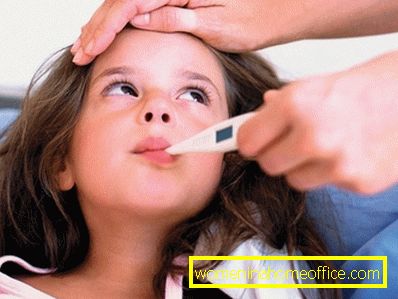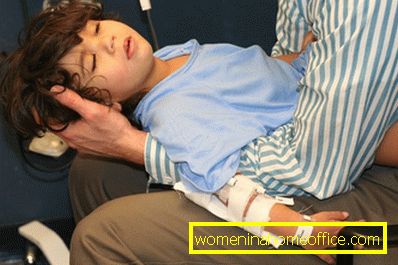Cramps in a child
The occurrence of seizures in young children is not a rare reason for seeking medical attention. Sometimes, convulsions in babies are a manifestation of the reaction to elevated body temperature, and in some cases have a real pathological basis. These are usually ion exchange disorders, any injuries, etc.
Cramps in a child: what is it?

Convulsions are nothing more than a sudden and involuntary contraction of skeletal muscles, which often passes with impaired consciousness of varying degrees of severity.
Most of the diagnosed seizures occur in children. They can be explained by the imperfection of the nervous system, which is easily excitable under the action of almost any stimulus.
Parents should remember that there are several types of seizures, and all of them will be caused by different reasons, respectively, the treatment will be different. Seizures and convulsive syndrome in the neonatal period, in the first year of life, in early childhood and subsequent age are distinguished into a separate group. And if it is possible to talk with older children and find out what preceded the convulsions, then during the examination of the babies you have to rely only on the parents and on their attentiveness.
Main reasons
The causes of cramps will largely depend on the age of the child. But despite this, we can formulate several leading mechanisms that provoke seizures.
- First of all, these are infectious pathologies, including those that occur with damage to the central nervous system - various viral and microbial diseases. Secondly, intoxication with various substances, poisons or the waste products of microorganisms.
- Injuries to the head, brain, the formation of cysts, tumors, or hemorrhages in the brain area should not be ignored. Metabolic disorders that lead to malfunctioning of the nervous system are important.
- When examining a child with convulsions, the doctor will be primarily interested in the fact of heredity, birth trauma, or birth defects, diagnosed epilepsy.
- It is in epilepsy - convulsions the main and most typical symptom. But their occurrence is not a strict diagnostic symptom of the fact that the baby has epilepsy. Do not forget about the other reasons, which are enough. As a result, all the formative situations of the symptom can be divided into 2 large groups - epileptic and non-epileptic origin.
How do cramps occur in a baby?
The mechanism of the formation of convulsions is multifactorial in nature and directly depends on the cause of their occurrence. In addition, the age of the child has its value. But a fundamental factor in the occurrence of seizures is an overly excited area in the brain, which is formed for various reasons. In this focus should be dominated by the processes of excitation over the processes of inhibition. This area of excitation can migrate and move from one zone to another.
Sometimes, in the genesis of seizures, excessive stimulation of specific receptors in the brain structures is important. It can occur under the influence of various psychoactive or neurotropic drugs.

Febrile convulsions in children: description
Febrile convulsions in children and convulsions in children at a temperature are one and the same. And you can talk about this type in the case of the formation of convulsive seizures (convulsive) with hyperthermia (elevated body temperature) above 38 degrees in children in the age group up to 6 years. What matters is the absence of convulsive seizures in history.
If such convulsions occur, consultation with a specialist who will eliminate epileptic seizures is necessary. If the symptom appears after the age of six, then most likely it indicates epilepsy. According to statistics, about 5% of children under 6 years of age suffer from this type of seizures. Most clearly and often, they appear in the age from six months to 3 years.
The reasons that lead to the formation of this type of seizures are not fully known, but it is clear that the starting mechanism for their occurrence is the weakness of the inhibitory processes and the insufficient maturity of the child’s nervous system. These conditions and allow the occurrence of convulsions. But provoking their appearance can increase body temperature, for example, with SARS and other diseases, after vaccination, etc.
Febrile seizures can be tonic, in which there is a significant strain on all the muscles of a child — tilting the head back, rolling the eyes, bending the arms to the chest, straightening the legs. Muscle tone is replaced by rhythmic winches or jerks, which gradually become more rare and disappear. It can also be atonic - instant relaxation of all muscles and sphincters, an uncontrollable loss of feces and urine. Local seizures are characterized by twitching of the limbs and rolling of the eyes.
Quite often, during a convulsive seizure, the child loses touch with others, stops responding to the words of the parents, crying, and may turn blue and hold his breath. According to statistics, every 3rd child who experienced febrile seizures, has repeated symptoms with a rise in body temperature in the next.
What should parents do and what not?

In the event of convulsions, even febrile, it is necessary to call an ambulance. While she is on her way, parents should not get together and take action.
A child with cramps should lie on a hard surface, around him, there should not be objects that can cause injury. Parents need to turn the baby's head to the side. And in no case do not leave him alone during the attack. It is important to monitor the rhythm of breathing. If it is absent, you need to wait until the end of convulsions and artificial respiration, during an attack, it is useless to do artificial respiration.
In no case can not climb into the mouth of the child's fingers or any objects, it will only worsen the situation. It is worth remembering about chewing pressure, and this is about 250 - 300 kg, in addition, also sharp teeth. Throwing objects can cause vomiting, which will significantly aggravate the situation. After cessation of cramps, the child must be given antipyretic. During an attack, this can not be done!
Whatever the cause of seizures, can not do without expert advice. If the doctor insists on hospitalization, it is better not to refuse her. It is in the hospital that it will be possible to provide the best care for the child, and to examine the baby fully.